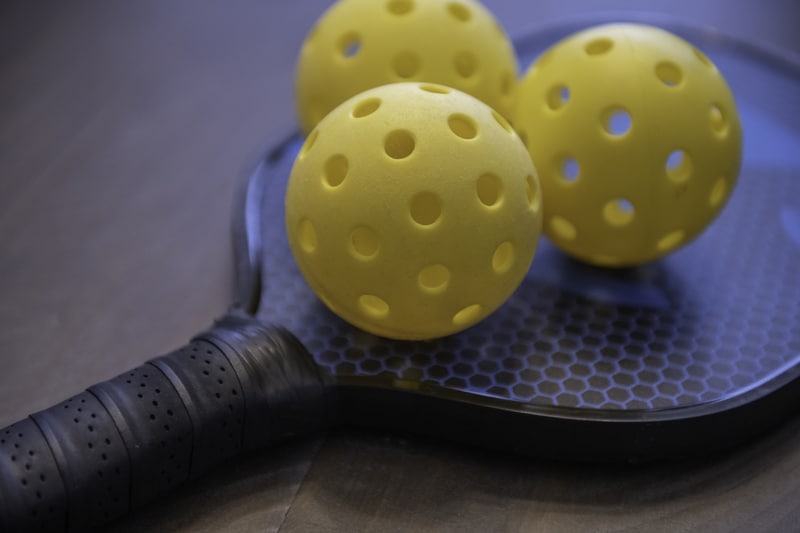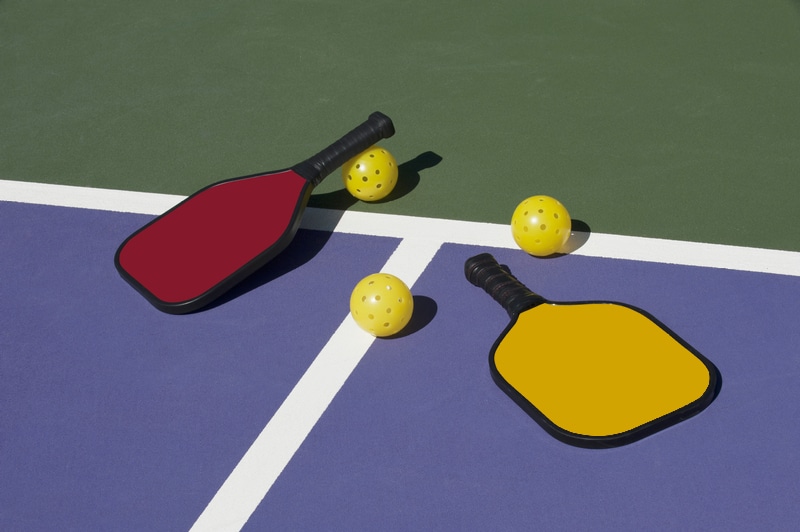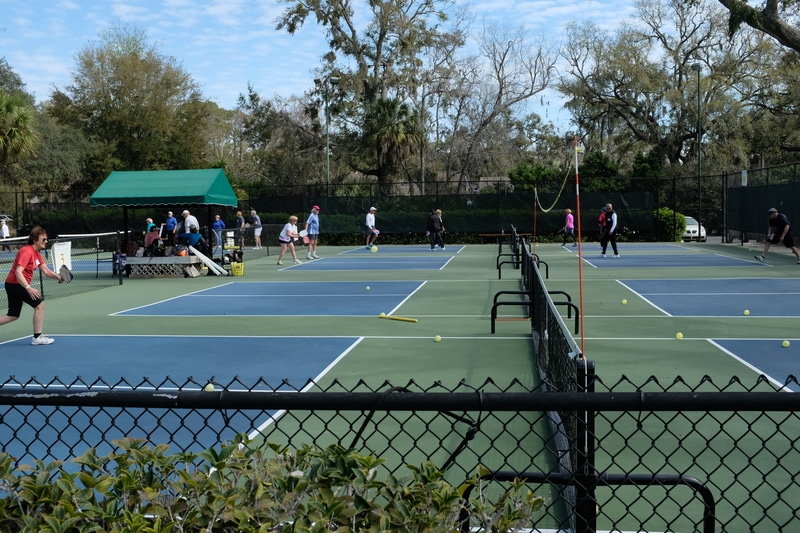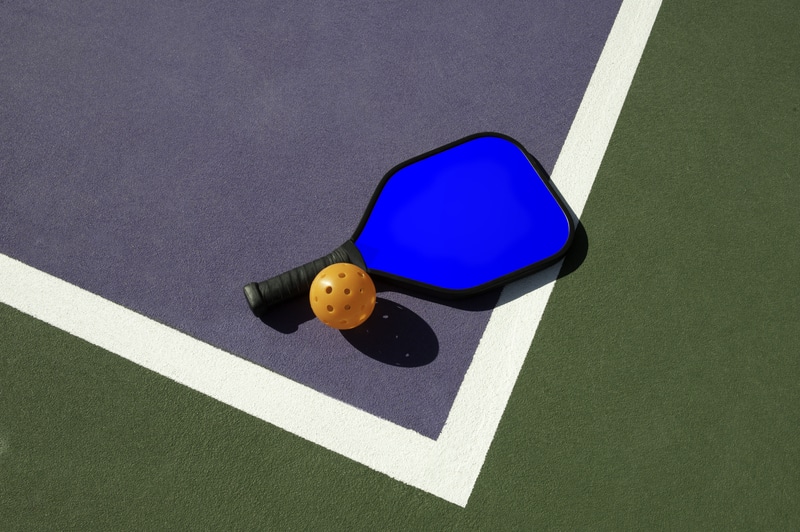Last updated on January 10th, 2023 at 09:06 pm
A term you may have come across while playing pickleball is Erne / Ernie. The spelling of the term changes who you ask, but the pronunciation is with the long e at the end. An Erne is a volley taken from outside the pickleball court of the non-volley zone, and it is an advanced shot that pickleball players love to hate. Essentially, it is hitting the ball while out of bounds and setting up an angled shot that will be difficult for your opponent to hit.
So, who invented the Ernie shot in pickleball? What makes an Erne legal during a game? Why is the Erne an Effective Shot to Hit during a match? How do you Hit an Ern Shot in Pickleball, and how do you defend against it?
Here is the complete breakdown of what an Erne is in pickleball.
Who Invented the Ernie in Pickleball?
Videographer Jeff Shank coined the name of the shot. He came up with the name after witnessing a tactic that was used by Erne Perry in 2010 when he played in the USAPA nationals in Arizona as a response to dinks at the sidelines. Though in truth, Erne did not ‘invent’ the shot (Erne himself acknowledged that he learned the move because another player used it against him back in the 1990s to great effect.)
However, even if Erne Perry did not invent the shot, the name of it came from his play.
What Makes an Erne Legal in Pickleball?
According to the official pickleball rules, any volley taken from outside the non-volley zone (NVZ, also known as the kitchen) makes it a legal play. Typically, a volley cannot occur within the non-volley zone, the seven-foot area between the net and the service areas (demarked by the NVZ line). Players can take advantage of this by dinking the ball, and hitting it softly, so it clears the net and bounces into the opposing non-volley zone.
Dinking slows the game and forces the opponents to wait for a bounce before returning the ball. It also creates a situation that can result in a fault – getting a player to volley the ball from the non-volley zone.
An Erne, however, does not take the shot from the non-volley zone – it is still outside the court and thus outside of the kitchen. The player must have their feet outside the NVZ (via out-of-play) when they hit the ball. If one of their feet is in the NVZ, then the Ernie shot won’t count.
Why is the Erne an Effective Shot to Hit?
Hitting an Erne is effective because it takes a dink from the opposing side and turns the advantage it creates on its head. It is a surprise shot usually taken out of a dinking rally, which means the players are close to the net.
A volley is not expected because the players are at or in the non-volley zones. When an Erne comes, it is a shock, and executed correctly can cause players to score. Dinking is an advanced level of play – Ernes is a devastating response to this strategy.
How to Hit an Ern Shot in Pickleball
The best way to learn how to hit an Erne is on Erne Perry’s Facebook video page! However, if you don’t watch the video, there are a few tips to gather below.
The Erne is deceptively simple – it requires you to either run to the side of the non-volley zone before hitting the Erne or jump across the corner to the side while hitting it. The trick involves being very aware of your footwork (you do not want to be in the non-volley zone when you volley the ball) and setting up the shot.
The most significant component of an Erne shot is patience when you attempt it. You must either wait or lure your opponent into dinking at the sidelines with a straight-ahead shot and then have your timing down to make the shot. Again, the shot looks surprisingly simple, but pulling it off requires practice.
How Do You Defend Against an Ernie Shot?
If you are the victim of an Ernie, you can hit the ball back toward the opponent’s body. With luck, the opposing player may be coming into the non-volley zone as you return it. If the ball touches they while they are there, it’s a fault. Targeting another player is a technical no-no, so don’t try to tag the player. If you are unsure about hitting the ball back toward another player, try to lob it over them instead.
Another way to defend against the Ernie shot is to limit the chances of it happening. That means that as a defender, you should be aware of your opponent’s position and not volley it in that area. By limiting the chances for your opponent to use that shot against you, you will be better in preparation for other shots to defend during a game.
Conclusion: What is an Erne in Pickleball?
An Erne is a beneficial shot to have in your arsenal, especially against opponents who dink well during matches. It is a legal shot if you stay out of the non-volley zone. Using the Erne shot can also change how your opponent defends against you for the rest of a match. Since they know you can perform this shot, they might play differently, which can throw off their game.
Defending yourself against an Erne is very difficult, but there are ways you can prepare for it. To start, you should limit the chances you give your opponent to use that shot against you. Second, if your opponent hits that shot toward you, try to hit it directly at them in play. If the ball hits your opponent in the NVZ, it will be a point for you.
Similar Posts:
What are the Pickleball Serving Rules?
What is Stacking in Pickleball?
Can You Play Pickleball on a Tennis Court?
What are the 5 Rules of Pickleball?
Can You Play Pickleball with 3 Players?
What is the Kitchen in Pickleball?
Can You Play Pickleball in the Rain?
How Big is a Pickleball Court?
Greg Kristan, owner of The Stadium Reviews, LLC and TM Blast, LLC, brings his extensive experience visiting over half of the MLB ballparks, along with numerous MLS, NHL, NBA, and NFL venues, to provide in-depth coverage on the bag policy, food options, and parking. He has also been interviewed about his experiences on several sports podcasts.







